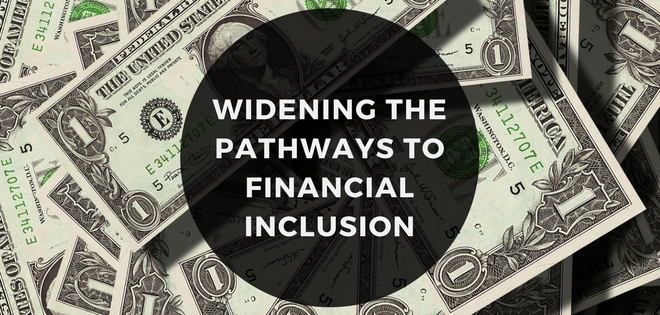
Earlier this month, the Federal Reserve released the results of their fourth annual Survey of Household Economics and Decisionmaking (SHED). There was some good news. Seventy percent of adults reported that they are either living comfortably or doing okay. However, 30 percent, or approximately 73 million adults, reported some difficulty getting by financially.
People of color, individuals with disabilities and those individuals with a high school degree or less all reported elevated levels of financial challenges. Those challenges included eviction, lack of access to credit and use of alternative financial services like check cashers, predatory lenders and pawn shops with higher fees and interest rates and no savings to deal with emergencies that may arise. For individuals with disabilities who are also people of color with limited educational achievement, these challenges are even more formidable. In fact, nearly one in two working-age adults with disabilities are unbanked or underbanked and more likely than their nondisabled peers to use alternative financial services on a regular basis that further secures their financial instability.
Why does this matter? Access to affordable financial services are a means to an end. Financial products and services are key tools and strategies to empower people to take control of their lives, fully participate in their communities and use their financial resources to create a higher quality of life. Relationships with mainstream financial institutions is a key step on a road to financial health and well-being. The recent analysis of FDIC data, from surveys of unbanked and underbanked households, reveal two major reasons for being unbanked. Survey respondents with disabilities identified costs and unexpected fees related to checking accounts and a lack of trust and confidence.
There is a growing movement to deal with both challenges. Just this week in Washington, D.C., more than 200 practitioners, regulators, financial institution representatives and city officials gathered for the biannual BankOn conference, led by the Cities for Financial Empowerment Fund and their charismatic president and CEO, Jonathan Mintz. There are a growing number of cities nationwide that are building diverse coalitions of community partners with the engagement of banks, credit unions and municipal leaders. Their goal is to connect economically vulnerable consumers with safe and affordable banking products.
From Seattle, San Francisco, Houston, Miami, Louisville, Newark, New York City and other cities across 40 plus states, there is the opportunity to open an affordable account that meets BankOn National Account Standards at more than 22,000 branches of participating financial institutions. The Standards require reduced or no monthly maintenance fee, reduced minimum deposit to open and maintain an account, free and unrestricted use of ATMs from the bank’s network, no overdraft fees, access to a debit or prepaid card and other customer service and functional requirements.
Multiple presenters from BankOn coalitions shared that a key element of a successful BankOn program is for the participating financial institution to work directly with a trusted community partner to be the bridge and messenger to the targeted group of individuals. Whether it be a United Way, a food bank or a city agency directly serving children and families, the venue and who is the messenger was critical to attract and explain the benefits of opening an account that meets the BankOn National Account Standards. In Louisville and Seattle, the coalitions have actively involved disability organizations.
Financial inclusion has been a defined public policy goal since the passage of the Community Reinvestment Act (CRA), 40 years ago, that created affirmative responsibilities for national and state chartered banks. Technology and market changes provide ample evidence of the need to modify and modernize CRA evaluations to continue and improve affirmative obligations on banks and other financial service providers to: 1) meet the credit needs of underserved individuals and communities; 2) invest in community development that benefits underserved low- and moderate-income populations; and 3) expand fair and equal access to other financial products and services for people who are economically vulnerable, including individuals with disabilities.
In 1977, when CRA was passed by Congress to respond to discriminatory lending practices by banks, there was no discussion about people with disabilities and fair and equal access to financial services. In 1977, there was yet to be the public outcry about the isolation, segregation and discrimination that individuals with disabilities faced in housing, the workplace and places of public accommodation. In fact, it wasn’t until 13 years later, with the passage of the Americans with Disabilities Act (ADA) in 1990, that Congress enacted comprehensive civil rights legislation that began to reshape inclusive community opportunities nationwide.
In 2017, nearly 27 years after the passage of the ADA, the time is long overdue for CRA evaluations of bank performance to specifically analyze a bank’s efforts and activities to provide fair and equal access to products and services to individuals with disabilities. Fair and equal access should also include requirements about accessibility of products, account statements, online communication and mobile banking.
What gets measured gets done. Without guidance issued by the Office of the Comptroller of the Currency (OCC), in concert with other regulators (FDIC, Federal Reserve), financial institutions have no standards to apply or urgency to act.
The last speaker at the BankOn conference was Grovetta Gardineer, Senior Deputy Comptroller for Compliance and Community Affairs at OCC. I had the opportunity to ask about updating guidance on CRA examinations to explain expectations and responsibilities of banks to serve individuals with disabilities across the multi-part CRA areas of evaluation. Ms. Gardineer’s answer to my question was direct and straightforward. She responded that this is something we need to do and it is on OCC’s list to move forward.
There is no single solution to the challenges of financial inclusion and building the financial capability of individuals with disabilities. However, there are clear strategies that could widen the pathways to financial inclusion. The adoption of BankOn standards by more financial institutions nationwide – to offer safe, affordable accounts with capability to respond to the needs of consumers with disabilities – is a major step forward. In addition, OCC taking the lead on guidance that examines CRA responsibilities for banks that will improve access and services for people with disabilities, would also be a game changer.
We should accept nothing less than full economic participation for all Americans.
Since its inception in 2005, National Disability Institute (NDI) remains the first and only national nonprofit organization dedicated exclusively to designing pathways to economic stability and mobility for persons with disabilities. Through public policy research and development and customized training and technical assistance, NDI has become a recognized leader nationwide demonstrating that individuals across the spectrum of disabilities can work, save for the future and advance their financial capability and economic stability. To learn more, visit www.realeconomicimpact.org. Take the DISABLE POVERTY pledge at www.disablepoverty.org.
